The Datalife Cycle
Research data refers to any information gathered, observed, created, or devised to back up our theories, hypotheses, or research discoveries. Generating this data demands considerable time, effort, and resources. Moreover, data plays a vital role in crafting research papers, securing funding via grants, and ensuring that both the scientific community and the public have confidence in our assertions.
Effective data management practices cover the entire data lifecycle from the beginning to the end of a project. Therefore, understanding each phase of this lifecycle, including secure storage, is crucial. In this section of the handbook, we’ll detail the different stages and discuss the procedures our lab adheres to in order to ensure the reliability, ethics, trustworthiness, and security of our data. An image representing each stage of the data lifecycle and its sub-stages is provided below. This image was created by the LMA Research Data Management Working Group at Harvard University (Cioffi, Goldman & Marchese, 2023).
While the diagram may appear complex initially, all the necessary information about this stage can be found in the subsequent pages of the handbook. The materials of the handbook are adapted from the open access resources provided by LMA Research Data Management Working Group and will always include a link to the original source.

References:
Cioffi, M., Goldman, J., & Marchese, S. (2023). Harvard Biomedical Research Data Lifecycle (Version 5). Zenodo. https://doi.org/10.5281/zenodo.8076168